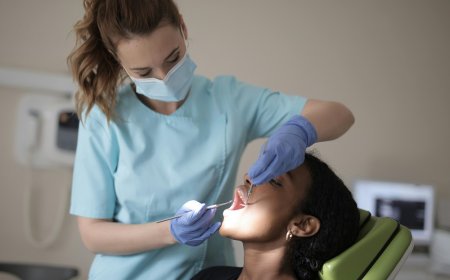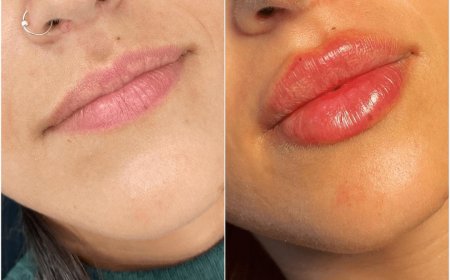Is Your Bent Nose Bone Affecting Your Breathing? know the reasons by Delhi’s Top ENT Surgeon
Struggling to breathe due to a bent nose bone? Discover how a deviated septum could be the cause and learn about effective treatment options from Delhi’s top ENT surgeon.

(Dr. Varun Gupta), M.B.B.S, M.S (E.N.T.), FPLS (Belgium), internationally trained ent, Head & Neck and Sleep Surgeon, HOD Indus Health, Delhi, Sr. Consultant Max Hospital)
Trouble breathing can lower your daily quality of life making sleep tough and cutting down your energy. Many blame allergies or sinus troubles, but the real problem might be physicallike a crooked or off-centered nasal septum. This issue is pretty common and affects 80% of people in one way or another. Still, most dont realize how much a twisted septum can mess with their ability to breathe or their overall health.
Understanding Nasal Septum Deviation and Its Impact on Breathing
A deviated nasal septum often causes problems with breathing. The nasal septum is a structure made of bone and cartilage that divides your nose into two nostrils. In an ideal situation, the septum stays straight ensuring air passes through both sides. But when it bends or shifts too far to one side referred to as a "bent nose," it blocks airflow and creates breathing issues.
Dr. Varun Gupta from Indus Hospital in Delhi specializes in rhinology. He says, "A deviated nasal septum can affect daily life by making breathing tough. Many people ignore what they think is 'just a crooked nose,' not realizing it might be the root of their constant breathing problems, trouble sleeping, or frequent sinus infections."
What Causes a Deviated Septum?
Several things can lead to a deviated septum:
-
Congenital Causes: Some individuals are born with a crooked septum. This might happen during development before birth and can worsen as they grow.
-
Injuries to the Nose: Accidents like car crashes, sports injuries, or even slipping and falling can harm the nasal septum and make it crooked.
-
Getting Older: Over time, the natural process of growing older can change the structures in the nose and lead to a crooked septum.
Symptoms of a deviated septum can range from stuffy noses to serious trouble with breathing. It is important to recognize these signs to diagnose and treat them .
Deviated Septum Symptoms: Recognizing the Signs
People with a deviated septum often struggle to breathe through one or both nostrils and may deal with sinus infections often. Many individuals overlook the signs of a deviated septum until their sleep starts being disrupted. Spotting these symptoms helps doctors provide better treatment.
Here are some of the symptoms:
-
Breathing Troubles: Trouble getting air through one or both nostrils, which might switch back and forth
-
Stuffy Nose: Persistent blockage that doesnt improve much with decongestants
-
Sinus Infections Often: Sinus problems that keep happening because drainage isnt good
-
Frequent Nosebleeds: Nosebleeds happen more than usual because the septums surface is exposed
-
Pain in the Face: Feeling pressure or discomfort near the nose or sinus areas
-
Problems Sleeping: Snoring trouble sleeping, or sleep apnea caused by difficulty breathing
-
Loud Breathing: Noticeable noise when active or moving around
Dr. Varun Guptaexplains, Many patients live with these symptoms for years believing they are just normal for them. When they get the right diagnosis and treatment, they understand how much their life has been impacted.
The Connection Between Deviated Septum and Sinus Problems
A crooked nasal septum can often cause long-term sinus problems. A bent septum may block the usual drainage paths of the sinuses. This blockage can lead to trapped mucus that creates a breeding ground for bacteria.
Patients often feel much better after having nose surgery to fix sinus issues when experienced doctors perform the procedure. The surgery not only fixes the misshaped septum but also improves how the sinuses drain. This can lower how often and how sinus infections occur.
Allergic Rhinitis and Deviated Septum: A Complicated Relationship
Treating allergic rhinitis involves fixing any structural problems inside the nose. When someone has allergic rhinitis along with a deviated septum, the symptoms can feel more intense.
Dr. Varun Guptasays, Many patients come to us after years of trying treatments for allergic rhinitis without much success. After a closer look, we often find they also have a major septal deviation. The latest approaches in Allergic Rhinitis Treatment include using medication, making changes to daily habits, and at times, surgery to tackle both issues at once.
This connection works in both directions:
-
Swelling in nasal tissues from allergies can make even a small deviation feel more noticeable.
-
A deviated septum can worsen allergy symptoms because it blocks airflow and drainage.
-
Treating both problems at the same time often leads to better results compared to treating just one.
Diagnosis: When to Consult a Rhinology Doctor
You need to see a rhinology doctor to get the right diagnosis for nasal structure issues. If you face ongoing nasal congestion, trouble breathing, frequent sinus infections, or problems sleeping, its a good idea to get checked by a specialist.
Dr. Varun Gupta is an experienced rhinology expert who specializes in handling nasal disorders. During visits, he performs:
-
Physical Check-Up: Doctors check the nose to see the nasal passages.
-
Nasal Endoscopy: They use a small tube with a light and camera to look inside the nose and sinuses.
-
Imaging Tests: Sometimes a CT scan helps show a detailed picture of the nasal and sinus areas.
To diagnose a deviated nasal septum, ENT specialists perform a complete evaluation. Catching it early can help avoid further problems or long-term issues.
Treatment Options for Deviated Septum
Treatments for a deviated septum range from using medicines to getting surgery. The treatment depends on how bad the symptoms are and how much the septum is out of place.
Non-Surgery Options
To handle mild cases or when surgery is not needed right away various non-surgical methods can ease symptoms:
-
Nasal Steroid Sprays: These sprays work to lower swelling inside the nasal passages.
-
Antihistamines: These can help control allergy-related symptoms that might make breathing harder.
-
Nasal Strips: These strips stick on the nose's surface and can help with airflow.
-
Humidification: Adding moisture keeps nasal passages from getting dry and irritated.
-
Nasal Irrigation: Using saline rinses can clear out mucus and things that cause irritation.
Surgical Deviated Septum Treatment
Doctors suggest surgery for a deviated septum when simpler treatments do not work. Septoplasty is the go-to procedure and is often paired with turbinate reduction.
Dr. Varun Guptaprepares personalized plans to treat a deviated septum. "Every nose is unique," he says. "Surgeries must be tailored to fix the specific structural problems each person has."
Septoplasty: A Nose Surgery for Sinus Issues
Dr. Varun Gupta focuses on modern nose surgeries to treat sinus problems at Indus Hospital in Delhi. This nose operation for sinus issues, including septoplasty surgery, involves correcting structural problems in the nasal passage to improve airflow, reduce blockages, and relieve chronic symptoms.
-
Preparation: Doctors carry out this procedure while the patient is under general anesthesia.
-
Incision: To reach the septum, surgeons create a small cut inside the nose.
-
Correction: They either straighten or remove part of the crooked bone and cartilage.
-
Reconstruction: The nasal tissues are placed back and stitched to hold everything in place.
-
Recovery: Most people get discharged the same day.
Healing after a nose surgery for sinus problems often takes about one or two weeks. Once healed many patients notice their breathing feels much better.
Comparison of Treatment Options for Deviated Septum
|
Treatment Approach |
Best For |
Advantages |
Limitations |
Recovery Time |
|
Medication (Nasal Sprays, Antihistamines) |
Mild symptoms, Temporary relief |
Non-invasive, No recovery time, Can manage symptoms |
Doesnt correct structural issues, Ongoing cost, Potential side effects |
None |
|
Septoplasty (Traditional) |
Moderate to severe deviation, Chronic breathing problems |
Permanent structural correction, Addresses root cause, High success rate |
Surgical procedure, Recovery period required, Potential complications |
1-2 weeks |
|
Septoplasty with Turbinate Reduction |
Combined issues (deviation + enlarged turbinates) |
Comprehensive solution, Addresses multiple causes, Better airflow results |
Longer procedure, Slightly increased recovery time, More extensive surgery |
2-3 weeks |
|
Functional Rhinoplasty |
Deviation with external deformity |
Improves both function and appearance, Comprehensive correction |
More complex surgery, Longer recovery, Higher cost |
2-4 weeks |
|
Balloon Sinuplasty (with septoplasty) |
Deviation with chronic sinusitis |
Less invasive than traditional sinus surgery, Faster recovery |
May not be suitable for all cases, Relatively newer technique |
1-2 weeks |
Why Choose Dr. Varun Gupta for Your Nasal Treatment
Dr. Varun Gupta stands among the top ENT specialists in Delhi NCR. He focuses on problems related to the nose and sinuses. His care combines skill and kindness so patients get treatments that suit their conditions best.
Main skills and areas he covers include:
-
Deep knowledge and hands-on work in nose and sinus surgeries
-
Skilled in using methods that require minimal invasion
-
Looks at nasal problems with a complete and thorough approach
-
Modern advanced equipment available at Indus Hospital in Delhi
-
Delivers great patient results and keeps them happy
Dr. Varun Guptasays, "My aim isnt to fix the structural problem but also to enhance the patients life as a whole. Breathing plays a key role in well-being. When nasal function is at its best, it can affect sleep, energy, and overall health."
The Patient Journey: What to Expect
To treat a deviated septum or other nasal concerns here is what happens during your visit to Dr. Varun Guptaat Indus Hospital:
-
First Appointment: The doctor checks your symptoms and examines your nose.
-
Finding the Problem: You get a clear breakdown of whats wrong and what might be causing it.
-
Planning the Treatment: The doctor goes over choices that fit what you need.
-
Going Through the Procedure: If surgery is needed, the doctor explains what will happen.
-
Helping You Recover: You get full care after surgery and regular check-ins.
-
Keeping Results Lasting: They provide ongoing help to make sure the improvements stay.
Care After Surgery and Recovery
Effective treatment for a deviated septum fixes the structural problem and tackles any related issues. After septoplasty or similar nasal surgery, recovering well is key to achieving the best possible outcome.
-
First Few Days (1-2 days):
-
Keep your head raised and rest.
-
Use a cold compress to help lessen swelling.
-
Take prescribed medicine to handle any pain.
-
Refrain from blowing your nose during this time.
Next Few Weeks (1-2 weeks):
-
Some nasal congestion and drainage are expected.
-
follow instructions on how to clean the area.
-
Stay away from heavy physical activities for now.
-
Make sure to go to your follow-up checkups.
Ongoing Healing (3-6 weeks):
-
ease back into your regular activities.
-
The inside tissues will keep healing over time.
-
You may notice breathing improving.
Conclusion: Breathing Better Starts with Proper Diagnosis
If you struggle with breathing problems, repeated sinus infections, or trouble sleeping, dont just assume you have to put up with these issues. A deviated septum could be the reason behind them, and there are ways to fix it.
At Indus Hospital in Delhi, Dr. Varun Gupta examines and treats various nasal structural problems, including deviated septums and related issues. Known as one of the top rhinology specialists in Delhi NCR, he focuses on nasal surgeries that help solve sinus-related problems. Many patients have breathed easier and felt healthier thanks to his care.
To meet with Dr. Varun Gupta, reach out to Indus Hospital using [contact information]. Start your journey toward better breathing and living today.






































